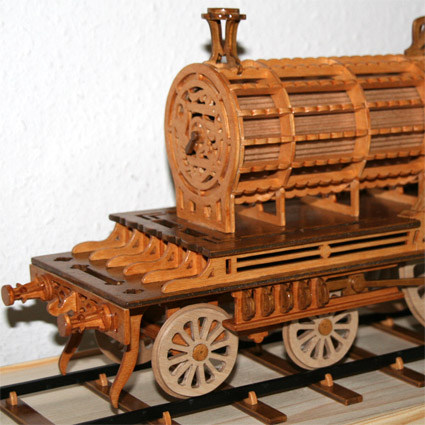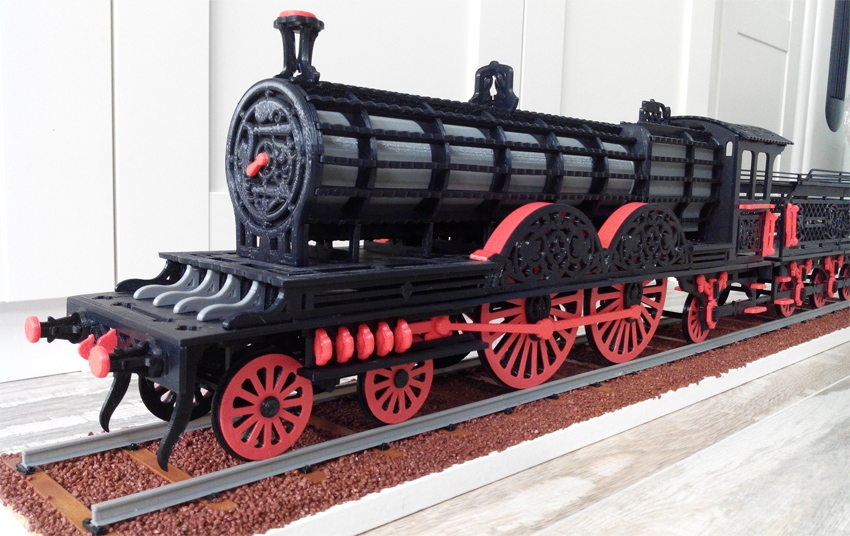 |
Finescrollsaw065 - Victorian locomotive |
|
 |
|
This pattern features a classic English locomotive with a freight car, distinguished by its evocative and captivating design. Wherever it's placed, it’s sure to become a focal point. The entire train is adorned with intricate fretwork, adding to its charm. Construction poses no significant challenges, though extra care is needed when shaping the locomotive’s roof. Made from thin wood, it must be carefully bent and glued into place. Aside from this minor detail, the project is well within reach of any intermediate scroller with patience. The train can be built with one freight car or multiple cars, depending on your preference. The locomotive model was originally published by Hobbies Handicrafts on two sheets. Unfortunately, I only possess one, and it’s in poor condition. I acquired it several years ago at an auction, along with several other vintage patterns, most of which were either incomplete or severely damaged. Despite these challenges, using just that single sheet and a photograph I found online, I managed to reconstruct the pattern featured on this page—though it required considerable effort. The pattern is designed for construction using 1/8-inch wood (with some pieces in 1/16- and 3/16-inch wood) or 3 mm wood (with some parts in 1.5 mm and 4.5 mm). However, it can be resized as desired. The following table provides the overall dimensions of the train based on the wood thickness used:
Please note that this pattern is registered and protected by copyright. It is available for purchase at €22 plus shipping. The pattern is computer made for complete precision and professionally printed for easy use in scroll sawing. Please write me to [email protected] to buy this pattern or for any questions. The picture above has been kindly sent by Georges Schmitz from Luxembourg. |
 |
 |
| The impressive front view of the train. Picture by Georges Schmitz from Luxembourg. | The detailed wheels system, with its axis, pistons and other mechanisms. Picture by Guillermo Morcillo from Castellón, Spain. |
 |
 |
| The driver's cabin. Observe the slightly bent roof. This piece requires the use of a thin wood. It is easily glued on four guide pieces. Picture by Georges Schmitz from Luxembourg. | The beautiful freight wagon, where different knick knacks can be stored for decoration. Picture by Guillermo Morcillo from Castellón, Spain. |

|
These three photos were kindly shared by Mr. Robert Holwill from the U.K. In the first, we see Mr. Holwill's grandfather, Mr. William Campbell, proudly posing with his model of the locomotive. Mr. Campbell built this model after returning from the First World War and went on to win a medal for it at an Industrial Exhibition in Edinburgh in 1921. Receiving this photo was a delight—it feels incredibly evocative, almost like peering into a bygone era when scroll sawing was a beloved and widespread hobby. On the right, we can see the medal Mr. Campbell was awarded. Notice its intricate design and delicate ornamentation, reminiscent of a time when craftsmanship and attention to detail were deeply valued—so different from today’s world, where mass production often prioritizes cost over quality and beauty. The locomotive model was originally published by Hobbies Handicrafts on two sheets. Unfortunately, I only possess one, and it’s in poor condition. I acquired it several years ago at an auction, along with several other vintage patterns, most of which were either incomplete or severely damaged. Despite these challenges, using just that single sheet and a photograph I found online, I managed to reconstruct the pattern featured on this page—though it required considerable effort. In the third photo, we see Mr. Campbell in his 70s. |

|
 |
| This picture has been kindly sent by Matien van der Els from the Netherlands: "It was really fun to make it. I scrolled every part individually. That means that I did not do any stack-cutting. When I needed a certain part 4 times I scrolled it four times. For those who want to make the train I can tell that the drawings are very accurate, and easy to handle. However the assembling is a very time consuming thing. Due to the fact that most parts of the train are made of 1/8 inches (3 mm) plywood, the train gets its stiffness at the end of the assembling. When gluing the parts together you have to take time to let the glue get dry enough before mounting the next part. For my train I added some parts of thick (12mm) plywood to the bottom of the first and second floor of the locomotive. These parts are not visible, but they bring some extra stiffness to the construction". |
 |
This picture has kindly been sent by Ester and Isaac Arditi from Israel. |
 |
| This picture has kindly been sent by Daniel Navarre from France. |
 |
| These pictures have kindly been sent by Toon Jansen from the Netherlands. |
 |
 |
| This picture has kindly been sent by Sante Taglieri from Italy. |
 |
| This picture has kindly been sent by Michel Susanne Demeester from Belgium. |
 |
| This picture has kindly been sent by Matteo Gentile from Foggia, Italy. |
 |
| This picture has kindly been sent by Antonio Valadés from Don Benito, Badajoz, Spain. |
 |
| This picture has been sent by Guillermo Morcillo from Castellón, Spain. |
 |
| This picture has been kindly sent by Michael Despotashvili from Tbilisi, Georgia. |
 |
| This picture has been kindly sent by Raffaele di Girolamo from Italy. |
 |
| This picture has kindly been sent by Santiago Fernández from Burgos, Spain. |
 |
| This picture has kindly been sent by Jose Rodrigo from Borriol, Castellón, Spain. |
 |
 |
| This picture has been sent by Alejandro Hernandez from Amposta, Tarragona. |
 |
| This picture has been sent by Francisco Calderón from Chile. |
 |
| This picture has been sent by Mr. Fieulaine from France. |
 |
| This picture has been sent by Gaston Varoqui from France. |
 |
| This picture has kindly been sent by Franco Girotto from Italy. |
 |
| This picture has been sent by Raul Linares from Mexico. |
 |
| This picture has been sent by Philip Mills from the USA. |
 |
| This picture has been sent by Bienvenido Real from Valladolid, Spain. |
 |
| This picture has kindly been sent by Alessio di Bello from Italy. |
 |
| This picture has kindly been sent by Hans Roelof from The Netherlands. |
 |
| This picture has been kindly sent by Antonio Gervasi from Switzerland. |
 |
| This picture has kindly been sent by Christy Upchurch from the USA. |
 |
| This picture has kindly been sent by Anthea Cammish from England. |
 |
| This picture has kindly been sent by Gino Rigole from Belgium. |
 |
| This picture has been sent by Pavel Markov from Ukraine. |
 |
| This picture has been sent by Dave Scott from the UK. |
 |
| This picture has kindly been sent by Gershon from Israel. |
 |
| This picture has kindly been sent by Francisco Vargas de Celis from Puertollano, Spain. |
 |
| This picture has been kindly sent by Ken Ahrens from the USA. This model made is made using Goncalo Alves and Maple. |
 |
| This picture has been kindly sent by Giovanni Iazetta from Italiy. |
 |
| This picture has been kindly sent by Claudio Della Croce from Italiy. |
 |
| This picture has been kindly sent by Juan Antonio Cavas from El Albujón, Spain. |
|
© Copyright 2024 Pedro López Rodríguez. All rights reserved. |